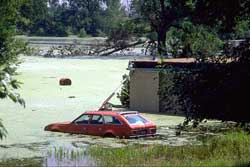
A University of Sheffield scientist has isolated a bacterium that may cause cancers in those with a genetic pre-disposition to the disease.
Dr Milton Wainwright, of the University’s Molecular Biology and Biotechnology department, researched historical literature and found that, as early as the 1890s, bacteria were believed to cause cancer. Unfortunately, none of the bacteria involved in these studies were ever kept or even named, making it impossible to verify claims about their role

An innovative engineering project could lead to fewer night-time accidents on badly lit roads.
It is developing a revolutionary way of assessing whether roads are equipped with appropriate levels of streetlighting.
The new assessment system is quicker, cheaper and more comprehensive than methods previously used. It can also help local authorities avoid the cost of unnecessary streetlight replacement.
The project is being carried out by engineers at Queen’s Univers

A Mayo Clinic study of more than 41,000 postmenopausal women in Iowa provides new evidence that the most common type of lung cancer in women is more closely linked to smoking cigarettes than previously recognized. The findings of the study will be published in the Dec. 15, 2002 issue of the American Journal of Epidemiology.
Lung cancer has been the leading cause of cancer death in women for more than a decade. In 2000, about 68,000 American women died of lung cancer. That’s compared to

A greater number of large “planetary sized waves” in the atmosphere that move from the lower atmosphere into the upper atmosphere were responsible for the smaller Antarctic ozone hole this fall, according to NASA researchers. The September 2002 ozone hole was half the size it was in 2000. However, scientists say that these large-scale weather patterns in the Earth’s atmosphere are not an indication that the ozone layer is recovering.
Paul Newman, a lead researcher on ozone at NASA’

nnovationen aus der industriellen Gemeinschaftsforschung
Pro Jahr gehen in Deutschland etwa 22 Mio. Paar Kinderschuhe über die Ladentheke. Rund 30 Prozent davon stellen deutsche Firmen her. Neben seinem modischen Aussehen und seiner richtigen Passform ist die Fähigkeit zur Wärme- und Feuchtigkeitsregulation maßgeblich für den Komfort eines Schuhs. Die Füße sollen warm und trocken bleiben und vor äußeren Einwirkungen geschützt werden. Der Abtransport des Fußschweißes durch Socke und S

The broad-scale warming expected from increased greenhouse gases may actually sap the strength of a typical El Niño, according to researchers at the National Center for Atmospheric Research (NCAR) in Boulder, Colorado. In contrast, the average El Niño during the last ice age may have packed more punch than today’s. The scientists have examined the past and future behavior of El Niño using a sophisticated computer model of global climate. They present their results this week at the annual meeting

– new calculation confirms standard model of particle physics. Contribution of hadronic vacuum polarization determined with unprecedented accuracy. The magnetic moment of the muon is an important precision parameter for…
Technique may prevent formation of unwanted waves that siphon off needed energy. Heating plasma to the ultra-high temperatures needed for fusion reactions requires more than turning the dial on a…

An international team of astronomers, led by researchers from the Astronomical Observatory of the University of Warsaw, have identified a new class of cosmic X-ray sources. The findings have been…

Antibody that Neutralizes Inhibitory Factors Involved in Nerve Regeneration Leads to Enhanced Motor Function after Acute Spinal Cord Injury. Researchers at 13 clinics in Germany, Switzerland, the Czech Republic and…

How the body’s natural killer cells could fight leukemia. Every year, some 13,000 people in Germany are diagnosed with leukemia. Despite intensive chemotherapy, around one in two of them die….

… eco-friendly reactor converts air and water into ammonia. Producing enough ammonia to feed the world comes with a large carbon footprint;. process described in new UB-led study could help…

How simulations help manufacturing of modern displays. Modern materials must be recyclable and sustainable. Consumer electronics is no exception, with organic light-emitting diodes (OLEDs) taking over modern televisions and portable…

“Neurons that fire together, wire together” describes the neural plasticity seen in human brains, but neurons grown in a dish don’t seem to follow these rules. Neurons that are cultured…

The quest for sustainable energy solutions has been a major focus of scientific research for decades. Solar energy, a clean and renewable source, has emerged as a promising alternative to…

With a processing speed a billion times faster than nature, chip-based laser neuron could help advance AI tasks such as pattern recognition and sequence prediction. Researchers have developed a laser-based…

New technology could remotely identify various types of plastics, offering a valuable tool for future monitoring and analysis of oceanic plastic pollution. Researchers have developed a new hyperspectral Raman imaging…

Artificial Intelligence (AI) has established a strong presence across industries, large and small. The “VoBaKI” research project has empowered small and medium-sized enterprises (SMEs) with an innovative tool to independently…